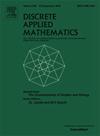图论优化问题中的公平性
IF 1
3区 数学
Q3 MATHEMATICS, APPLIED
引用次数: 0
摘要
图论问题的最优解具有随意性,可能导致不公平性。然而,将公平纳入此类问题可以通过多种方式实现。例如,公平性可以在个体层面、给定图的单个顶点或边缘或群体层面上定义。在这项工作中,我们详细分析了两种基于找到解决方案集上的概率分布的个人公平度量。一种方法保证均匀公平性,即当从这个概率分布中抽样时,实体成为解决方案一部分的机会是相等的。另一种方法是使每个实体在解决方案中被选中的最小概率最大化。特别地,我们揭示了计算这些个体公平度量实际上等同于计算超图的分数覆盖数和分数分区数。此外,我们还表明,对于我们归类为独立系统的一般问题,这两个度量是一致的。我们还分析了群体公平以及如何将其与个人公平措施相结合。最后,我们建立了确定匹配问题变体的群公平解的计算复杂度。本文章由计算机程序翻译,如有差异,请以英文原文为准。
Fairness in graph-theoretical optimization problems
There is arbitrariness in optimum solutions of graph-theoretic problems that can give rise to unfairness. Incorporating fairness in such problems, however, can be done in multiple ways. For instance, fairness can be defined on an individual level, for individual vertices or edges of a given graph, or on a group level. In this work, we analyze in detail two individual-fairness measures that are based on finding a probability distribution over the set of solutions. One measure guarantees uniform fairness, i.e., entities have equal chance of being part of the solution when sampling from this probability distribution. The other measure maximizes the minimum probability for every entity of being selected in a solution. In particular, we reveal that computing these individual-fairness measures is in fact equivalent to computing the fractional covering number and the fractional partitioning number of a hypergraph. In addition, we show that for a general class of problems that we classify as independence systems, these two measures coincide. We also analyze group fairness and how this can be combined with the individual-fairness measures. Finally, we establish the computational complexity of determining group-fair solutions for a variant of the matching problem.
求助全文
通过发布文献求助,成功后即可免费获取论文全文。
去求助
来源期刊

Discrete Applied Mathematics
数学-应用数学
CiteScore
2.30
自引率
9.10%
发文量
422
审稿时长
4.5 months
期刊介绍:
The aim of Discrete Applied Mathematics is to bring together research papers in different areas of algorithmic and applicable discrete mathematics as well as applications of combinatorial mathematics to informatics and various areas of science and technology. Contributions presented to the journal can be research papers, short notes, surveys, and possibly research problems. The "Communications" section will be devoted to the fastest possible publication of recent research results that are checked and recommended for publication by a member of the Editorial Board. The journal will also publish a limited number of book announcements as well as proceedings of conferences. These proceedings will be fully refereed and adhere to the normal standards of the journal.
Potential authors are advised to view the journal and the open calls-for-papers of special issues before submitting their manuscripts. Only high-quality, original work that is within the scope of the journal or the targeted special issue will be considered.
 求助内容:
求助内容: 应助结果提醒方式:
应助结果提醒方式:


